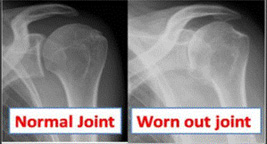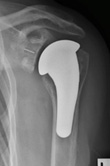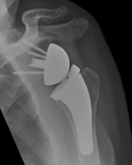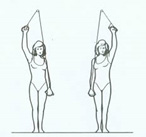Arthritis of the shoulder may be caused by several different processes: Gradual wear and tear (osteoarthritis) – can be age related (degenerative) Chronic inflammatory disease – for example rheumatoid arthritis Post traumatic – following prior trauma or dislocation of the shoulder Many other less common conditions
When the shoulder joint becomes arthritic it means that the cartilage of the joint (smooth gristle surface of the bone ends) has become damaged and/or lost. As a result the normally smooth joint surfaces become rough and uneven, and the joint does not move as easily. This can result in severe pain and stiffness of the shoulder.


When the joint damage becomes severe and the patient’s symptoms begin to have a significant impact on their quality of life, the most common surgical treatment is shoulder replacement. Shoulder replacement surgery has improved dramatically over the past 10 years, and there are now several different options to deal with shoulder arthritis.
Total Shoulder Replacement
When the shoulder is affected by arthritis but the surrounding small muscles of the shoulder (rotator cuff) are still in good condition, then the procedure most likely to be performed is a total shoulder replacement. This involves replacement of both the ball and the socket of the shoulder with specially designed artificial parts called prostheses, made of metal (usually titanium and cobalt-chrome) and polyethylene (a medical grade plastic).

A metal ball replaces the humeral head, secured into the humerus (arm bone) with a stem. The socket (glenoid) is replaced with a polyethylene prosthesis secured into the scapula (shoulder blade). The specific sizes of these components are determined at the time of surgery to best replicate your own normal anatomy. The aim of the operation is to replace the worn-out joint surfaces whilst preserving the rotator cuff and other remaining structures of the shoulder.
Reverse Shoulder Replacement
When the rotator cuff has ruptured (torn) or is non-functioning (due to age) the shoulder is deprived of one of its main stabilising elements. Under the action of the deltoid muscle the humeral head migrates upwards, resulting in loss of the fulcrum for elevation. The only way to restore stability and mobility in this situation is to provide new biomechanical conditions for better functioning of the deltoid, compensating for the lack of a functional rotator cuff. Hence the rationale for a reverse ball and socket shoulder replacement.

In this procedure the ball is placed on the socket (glenoid) side, being secured into the shoulder blade with screws. The socket is placed on the ball side, secured into the humerus (arm bone) with a stem. Although the reverse shoulder replacement looks very different it will not feel any different, and the intention is for it to function as close to possible like a normal shoulder. However given that it is performed in situations where a total shoulder replacement cannot be used it may have some limitations which your surgeon will explain to you.
Recovery after Surgery
Usually you will need to be in hospital for 2 to 3 nights after the surgery. I will provide you with information sheets and exercise sheets before you leave the hospital which will outline very clearly how to look after your arm following the surgery.
As a brief outline:
You will spend anywhere from 2 to 4 weeks with your arm in a sling. In general the sling is removed sooner following reverse shoulder replacement, mainly because there is less soft tissue repair work to protect. The sling can be removed for showering purposes and when you are doing your exercises. You cannot drive during this period.

You will then spend another 4 to 6 weeks limited to light weight waist level use of the arm. This is to allow further healing whilst you continue to work on regaining ‘passive’ range of motion in the shoulder. You will be able to start driving and do light desk type of work during this period. The use of pulleys may also be used to help regain overhead elevation during this period.
More formal rehabilitation including stretching in other planes and strengthening does not begin until the 10 week mark. This is when physiotherapy may also be helpful, especially following total shoulder replacement, as recovery of strength tends to be very slow. Physiotherapy is generally not necessary following reverse shoulder replacement surgery - starting to use the arm as normal will often provide all the rehabilitation that is required from this stage.
How quickly you are back doing your normal daily activities with comfort and good mobility is variable, and generally depends on the underlying pathology that necessitated the shoulder replacement. In general recovery is a lot quicker than many of the other shoulder surgeries that I perform, and it is important to appreciate that you will keep improving for 18 months to 2 years.
You will need the Adobe Reader to view and print these documents. 

